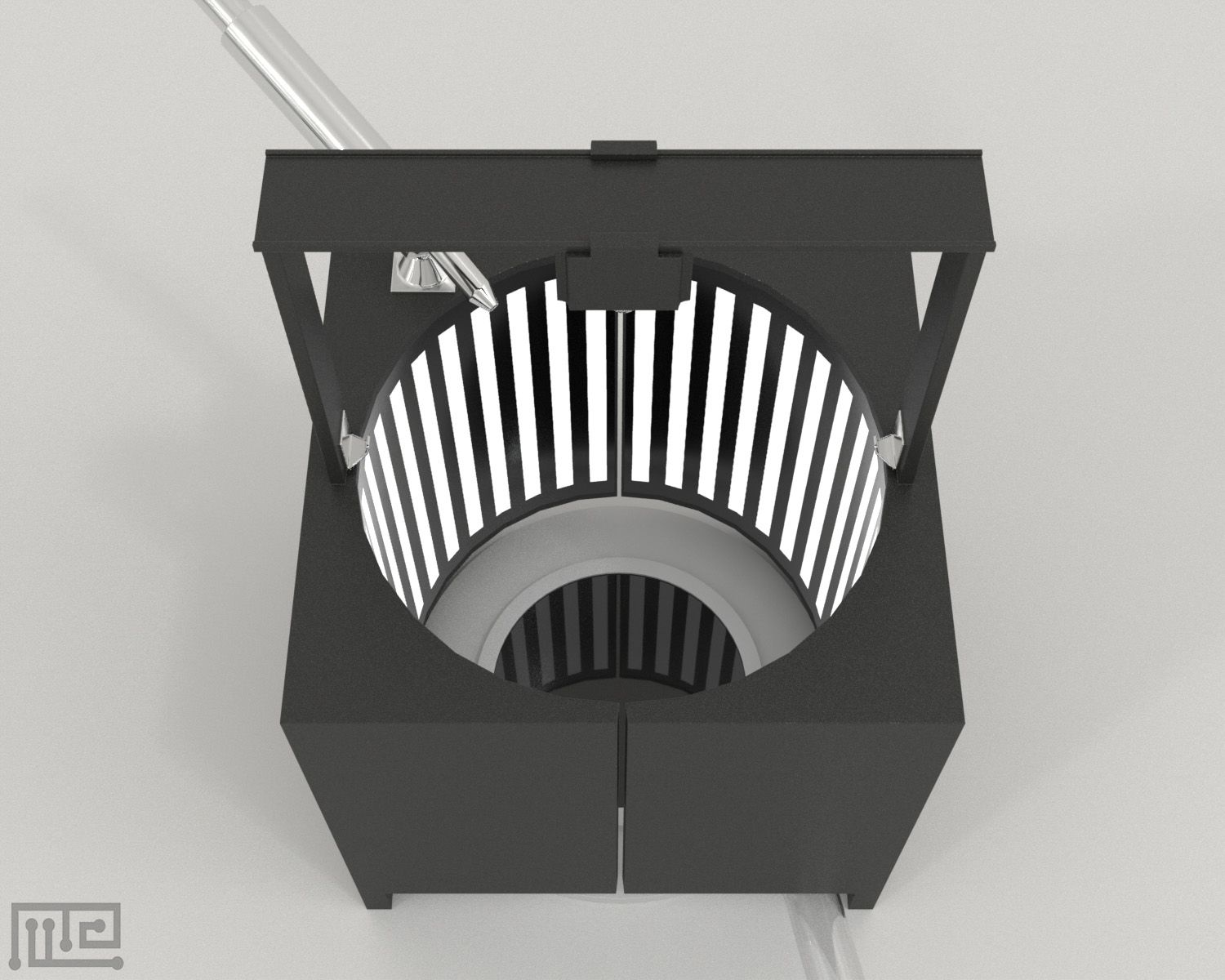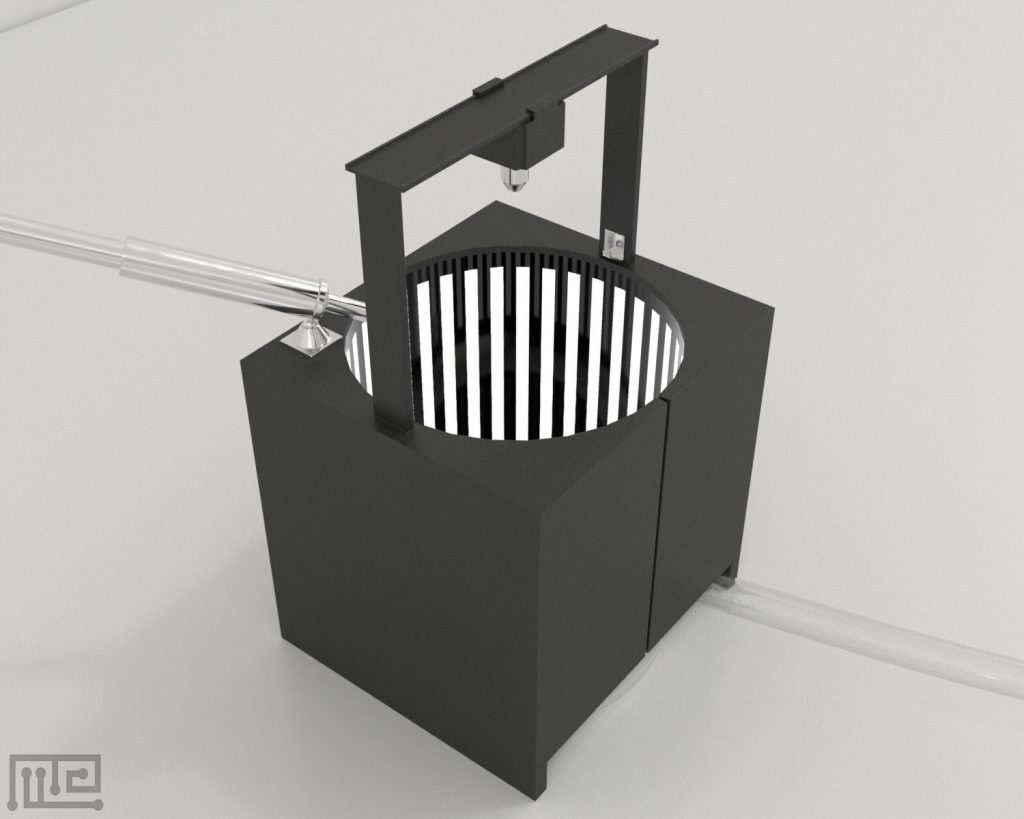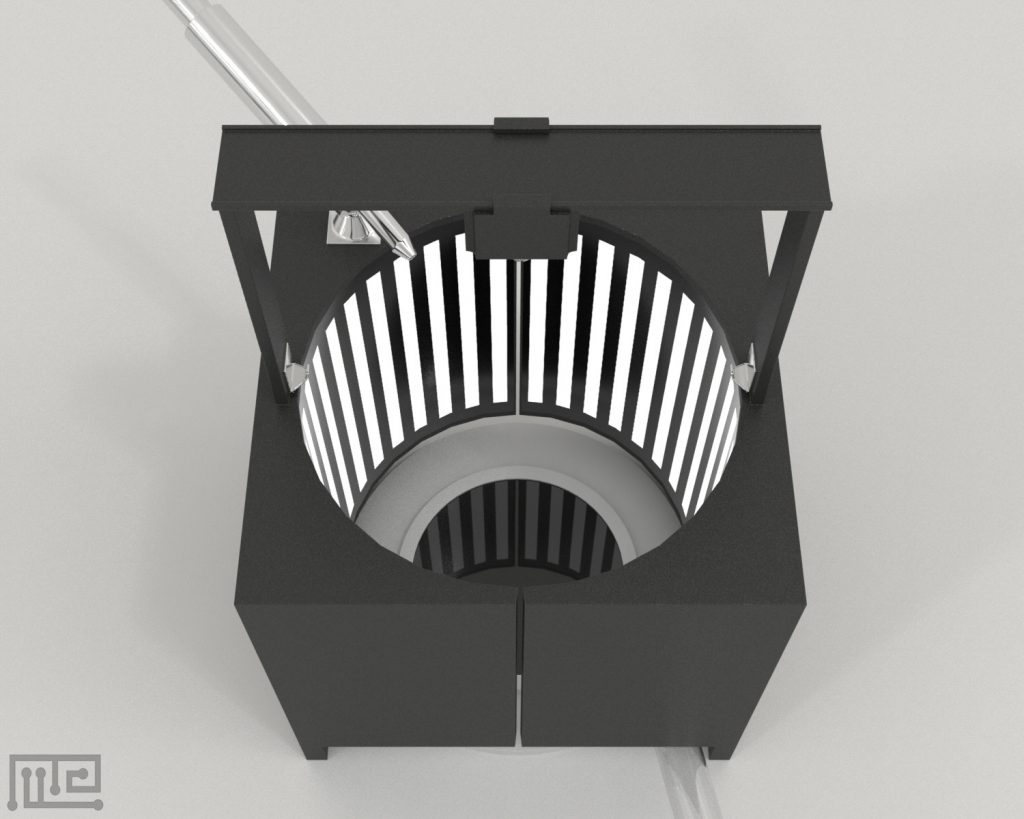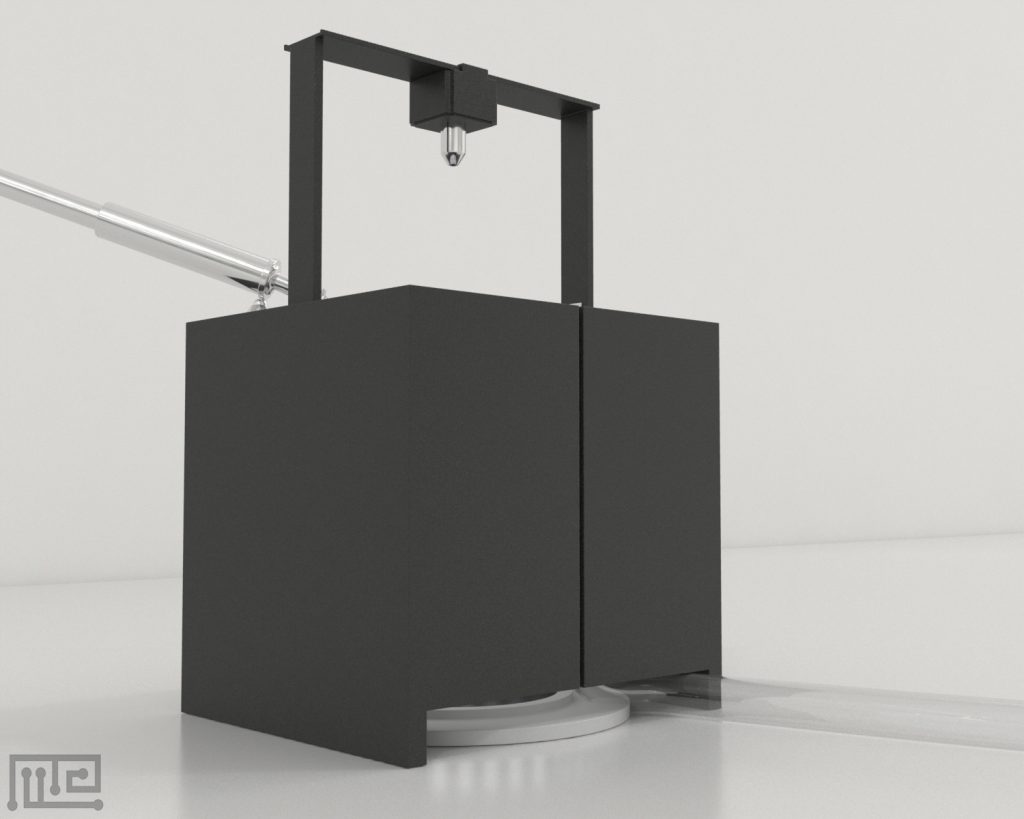The Drosophila Visual and Olfactory Apparatus can be used to examine sensorimotor interactions in Drosophila.
Flies were suspended between an opticalsensor and an infrared light-emitting diode. Thebeating wings cast a shadow onto the sensor. Associated electronic components track the motion of both wings and measure the amplitude and total frequency of each wing stroke.
While tethered in place, flies attempt to steer by modulating the difference between the left and right wingbeat amplitude (∆WBA). To create closed-loop conditions, the time varying ∆WBA signal is coupled to the angular velocity of a visual pattern created by a cylindrical array of green LEDs.
Mazeengineers offers the Drosophila Visual and Olfactory Apparatus.
Price & Dimensions
Drosophila Visual and Olfactory Apparatus
$ 3490
+S&H- Black opaque device with a cylindrical flight arena.
- Elevated platform with infrared light.
- Sensor to analyze the wingbeats of the subjects.
- Visual cues.
- The bottom of the apparatus is provided with two 30 ml vials to carry both odor and odorless stimuli.
- Delivery tubes.
Documentation
Introduction
The Drosophila Visual and Olfactory Apparatus is used to understand sensorimotor interactions in Drosophila. Like other flying insects, Drosophila requires a number of sensory modalities along with proper motor control for survival and interaction with the environment (Trimarchi & Schneiderman, 1995; Brembs & Heisenberg, 2001). They receive and integrate a variety of sensory stimuli and send the information to the relevant central pattern generator for the execution of the motor function. (Fyre & Dickinson, 2004).
The Drosophila Visual and Olfactory Apparatus is a popular apparatus to assess visual and olfactory sensorimotor interactions in Drosophila. The apparatus was originally devised by Götz, (1964) and was repeatedly upgraded by Heisenberg and Wolf, (1984). The apparatus consists of a cylindrical flight arena for a static tethered flight of subjects. The subjects can be exposed to visual cues i.e., a pattern of vertical stripes that expands from the subject’s right and contracts to the left through wrap around light-emitting diodes (LED). In contrast, olfactory cues are provided through vials powered with a mass flow controller at the bottom of the apparatus. The apparatus works by illuminating the subject from the above by an infrared light that creates the subject’s wingbeat shadow on the sensor placed at the bottom of the apparatus. This allows the apparatus to measure the subject’s motor response against both visual and olfactory cues alone or in combination. The Drosophila Visual and Olfactory Apparatus is very effective in understanding complex sensory-motor interaction for navigation and foraging behavior in Drosophila.
Other apparatus used in studying behaviors in drosophila include the Drosophila Gravitaxis Maze, the Drosophila maze array, the Drosophila Y maze, and the Drosophila shallow chamber.
Apparatus and Equipment
The Drosophila Visual and Olfactory Apparatus is a black opaque apparatus with a cylindrical flight arena. Above the cylindrical arena, rests an elevated platform which is provided with infrared light. The apparatus is provided rigid support to statically tether the subject in the middle of the cylindrical arena. At the bottom of the apparatus, there is a sensor to analyze the wingbeats of the subjects. The inside wall of the cylindrical arena is provided with green light-emitting diodes (LEDs), which provides visual cues to the subject. The output of the wingbeat sensor is connected with the LEDs creating a closed-loop visual landscape. The bottom of the apparatus is provided with two 30 ml vials to carry both odor and odorless stimuli. Each vial is connected with delivery tubes, which are further connected to the distal end of a single pipette tip (4·mm long and <1·mm3 in volume). To provide a continuous stream of vapors at the speed of 280·mm·s–1, the vials are connected to a mass flow air controller through a solenoid valve. The solenoid valve automatically switches vapor delivery between odor cues and odorless cues. A brass suction tube is also provided behind the subject to remove residual odor cues.
Training Protocol
Keep subjects on a 12-hour light to 12-hour dark cycle and carry out experimentation within 6 hours of the onset of experimentation day. Clean and ventilate the apparatus before each trial. Preload the delivery tubes with odor vapors from the vials to avoid delay in vapor delivery caused by a solenoid switch. Tether each subject at the dorsal junction of head and thorax to a small tungsten wire under cold anesthesia. Allow them to recover for at least 1 hour before carrying out the experiment. A tracking and recording system such as the Noldus Ethovision XT can be used to assist with observations.
- Visual task
Tether the subject in the middle of the cylindrical tube between wingbeat sensor and infra-red diode. Expose the subject to the visual stimulus presented through green LEDs in the inner lining of the cylindrical arena. Expose subjects to odorless cue provided by a vial at the bottom of the apparatus. Introduce a collision stimulus by creating a 1.25 seconds bias to the loop. Conduct trial for 30 seconds.
- Olfactory task
Tether the subject in the middle of the cylindrical tube between wingbeat sensor and infra-red diode. Expose the subject to the visual stimulus presented through green LEDs in the inner lining of the cylindrical arena. Expose subjects to odorless cue provided by a vial at the bottom of the apparatus. Conduct trial for 30 seconds.
- Simultaneous visual and olfactory task
Carry out the experiment by filling one vial with odor cue and the other by odorless cue. Tether the subject in the middle of the cylindrical tube between wingbeat sensor and infra-red diode. Expose the subject to the visual stimulus presented through green LEDs. Introduce a collision stimulus by creating a 1.25 seconds bias to the closed-loop. Conduct trial for 30 seconds.
Literature review
Investigation of visual and olfactory stimuli on sensorimotor control of Drosophila melanogaster
Frye & Dickinson (2003) investigated the interaction between visual and olfactory stimuli on the motor control of wings during the flight in Drosophila melanogaster. 2–3-day-old female flies (n=22) were used, which were tethered in The Drosophila Visual and Olfactory Apparatus. Motor responses to visual and olfactory stimuli were then tested. The olfactory stimulus was vinegar, while the visual stimulus was a LED generated vertical stripe that expands in the left and contracts towards the right of the fly. The flies were exposed to odor stimuli and visual stimuli alone and in combination. A collision stimulus was introduced by creating 2.5-sec bias to the closed-loop. The results showed that flies modulate their wingbeat frequency and amplitude in response to visual and olfactory stimuli alone and in combination. During the tethered flight of flies (n=16) in closed-loop condition, there was a symmetric increase in wingbeat frequency and amplitude by presenting an olfactory stimulus. However, no change in magnitude or time course of collision avoidance reflexes was observed in closed-loop conditions (n=10). In visual closed-loop conditions, flies (n=10) responded to lateral expansion by asymmetric changes in wingbeat amplitude resulting in a reduction of total wingbeat amplitude. The magnitude and time period of visual reflex was not changed on presenting an odor stimulus (n=16). A linear interaction was observed between motor responses to visual and olfactory stimuli. It was observed that the sum of motor responses to both visual and olfactory stimuli was approximately similar to the responses when both stimuli are presented together (n=22). The results of this study concluded that visual and olfactory stimuli prompt independent motor responses that superimpose each other when presented together. The study reveals that during flight, drosophila navigates an odor stimulus, while the visual stimuli enhance the olfactory sense by ceasing or resetting odor stimulated motor responses.
Data Analysis
- Wingbeat frequency of right and left wing (WBF)
- Wingbeat amplitude of right and left wing (WBA)
- Total amplitude of right and left wing (ΣWBA)
- Difference in amplitude between the right and left wings (∆WBA)
- Trajectories of visually mediated motor reflexes
Strengths and Limitations
Strengths
The Drosophila visual and olfactory apparatus does not require extensive pretraining of subjects. The task performance is easy and requires a minimum amount of time. Different visual stimuli can be introduced using this apparatus.
Limitations
The Drosophila visual and olfactory apparatus is limited to odor and visual cues. Improper handling and presence of unsolicited stimuli can alter task performance. Factors such as age, gender, and strain of the subject may affect task performances.
Summary
- The Drosophila visual and olfactory apparatus is used to understand the role of visual and olfactory cues on sensorimotor activities of Drosophila.
- The apparatus is computer operated and is composed of a cylindrical flight arena.
- The apparatus provides visual stimulus through LEDs provided in the inner wall of the cylinder, while odor cues are provided as saturated vapors generated through vials connected to the mass flow air controller.
- The apparatus works under closed-loop conditions.
- Apparatus is easy to operate, and each trial requires a minimum amount of time.
- The apparatus is very useful in understanding complex interactions of visual and auditory stimuli on navigation and foraging behavior in flies.
References
- Brembs, B., & Heisenberg, M. (2001). Conditioning with compound stimuli in Drosophila melanogaster in the flight simulator. The Journal of experimental biology, 204(Pt 16), 2849–2859.
- Frye, M. A., & Dickinson, M. H. (2004). Motor output reflects the linear superposition of visual and olfactory inputs in Drosophila. The Journal of experimental biology, 207(Pt 1), 123–131. https://doi.org/10.1242/jeb.00725
- Götz K. G. (1964). Optomotorische Untersuchung des visuellen Systems einiger Augenmutanten der Fruchtfliege Drosophila [Optomoter studies of the visual system of several eye mutants of the fruit fly Drosophila]. Kybernetik, 2(2), 77–92. https://doi.org/10.1007/BF00288561
- Heisenberg, M., & Wolf, R. (1984). Vision in Drosophila. In Genetics of Microbehavior (pp. 1-250). Newyork: Springer.
- Trimarchi, J. R., & Schneiderman, A. M. (1995). Different neural pathways coordinate Drosophila flight initiations evoked by visual and olfactory stimuli. The Journal of experimental biology, 198(Pt 5), 1099–1104.
Request a quote
"*" indicates required fields




